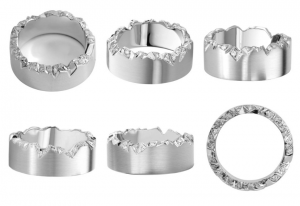The European Union trade mark nº 18948203 consists of a three-dimensional mark, represented by a white background upon which six silver rings with an irregular shape are displayed. On the 8 of November 2023, the mentioned trade mark was applied for in class 14 ( jewellery). However, on the 29 of April 2024, the application was refused pursuant to Article 7(1)(b) EUTMR regarding the devoid of distinctive character.

The decision was based on the appearance of the represented rings, the examiner considered that the shape applied for did not differ significantly from other basic shapes customary in trade for the goods claimed, it merely represented a variation. For this reason, the examination board did not appreciate any distinctive character and concluded that the relevant public wouldn’t be able to understand the sign applied for as a reference to a particular undertaking, but rather as a customary and obvious appearance of the goods themselves.
In response to the contested decision, the applicant filed a notice of appeal requesting its annulation on the following grounds. First, the applicant argued that the examiner had not addressed the core of the legal issue by taking into account an incorrect representation of the sign. Secondly, the applicant alleged that the overall impression of the rings appearance
has not been taken into account, and proceeds to list some characteristic features of the rings shape that were not mentioned in the contested decision. The applicant indicates that the mentioned characteristics are not commonly known in the field of jewellery and therefore cannot comply with the norm or be customary in the sector which means that the applied mark is capable of indicating the commercial origin. According to the applicant, the shape of the rings is unique on its overall impression because the irregular side of the ring (which has chopped flanges with curved precious stones) is perceived by the observer in a particular way that allows them to identify a specific commercial origin.
The criteria taken into account by the Fifth Board of Appeal argues that in order to assess the distinctive character of a trade mark, it must serve to identify and distinguish the goods and services for which the registration is applied for. Moreover it has to be considered that consumers are not in the habit of making assumptions about the origin of a product on the basis of their shape, which makes it difficult for three-dimensional marks to prove its distinctive character. In this sense, The Board notes that the shape for which registration is sought resembles the shape most likely to be taken by the product in question, the less distinctive character it will have. In other words, only a mark which departs significantly from the norms or customs of the sector and thereby fulfils its essential function of indicating origin, is not devoid of any distinctive character. Therefore, the mere fact that the shape is a variant of a common shape of that type of product is not enough to consider the distinctiveness of it. For this reason, it is necessary that the average consumer is capable of distinguishing the products from other undertakings without paying special attention. In this case, the overall impression of the trade mark must be considered.
In line with the above reasoning, the Fifth Board of Appeal concludes that in the jewellery field, the design of a product can vary considerably. Therefore the applied sign will be perceived as a representation of the shape of the goods which does not depart significantly from the norm or customs of the sector, but merely represents a variant. Nor the shape or the characteristics of the rings are capable of allowing the consumers to identify the origin of the product. The Office considers that the presence on the market of a significant number of shapes regarding the mentioned goods, makes it unlikely for consumers to identify a particular shape as belonging to a particular manufacturer instead of considering it to be merely one of the many shapes available on the market. The Board presents a list of similar rings from competitors which proves that the trade mark rings don’t depart significantly from the norm and customs of the sector which proves that consumers will perceive the trade mark applied for as a variant of the customary product shape or as a decorative design element, but not as an indication of the commercial origin of the goods.
The applied Trade mark cannot be registered in Class 14 owing to the ground for refusal under Article 7(1)(b) EUTMR and therefore the appeal is dismissed.
Decision of the Fifth Board of Appeal of 25 November 2024 in case R 1154/2024-5.


 Español
Español Deutsch
Deutsch